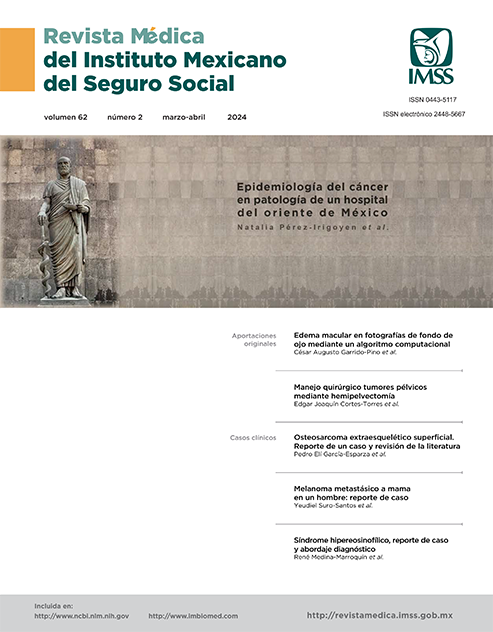Umbilical hernia and clinical course of patients with bile duct atresia
Main Article Content
Keywords
Hypertension, Umbilical, Portal, Hernia, Biliary Atresia
Abstract
Background: Bile atresia is children's leading cause of cirrhosis. Its high morbidity and mortality are explained by its complications, including gastrointestinal bleeding and portal hypertension. Umbilical hernia has been embryologically and clinically associated with portal hypertension and cirrhosis; however, the clinical evolution of patients with bile atresia and umbilical hernia is unknown, so the aim of the study is to describe this link.
Objective: To determine the prevalence of the coexistence of AVB and HU in patients in a tertiary hospital, and describe the clinical evolution of these patients with respect to the presence/absence of HU as a strategy in the search for prognostic factors of morbidity and mortality.
Material and Methods: This is an observational, descriptive, retrospective, and longitudinal study that included patients with bile atresia in a tertiary pediatric hospital. The variables related to bile atresia were analyzed, and the clinical evolution was described according to the presence or absence of UH.
Results: 56 patients with bile atresia were included, of which 69.6% were females. Portal hypertension occurred in 80.4%, with the presence of collateral venous network, gastrointestinal bleeding, ascites, and hepatomegaly being the indirect clinical data most often presented. The frequency of coexistence of umbilical hernia and bile atresia was 75%. Portal hypertension, collateral venous network, gastrointestinal bleeding, ascites, and small esophageal varices were the significantly more prevalent variables in patients with umbilical hernia.
Conclusions: Patients with bile atresia have a greater possibility of developing umbilical hernia and that it is associated with a more advanced evolution of portal hypertension and its associated signs and complications.
References
Girard M, Panasyuk G. Genetics in biliary atresia. Curr Opin Gastroenterol. 2019;35(2):73-81. Disponible en: http://dx.doi.org/10.1097/mog.0000000000000509.
Sooraj K, Shivani F, Hassan Khan M, et al. Frequency of causes of portal hypertension in children. Cureus. 2022;14(6):e25934. Disponible en: http://dx.doi.org/10.7759/cureus.25934.
Schreiber RA, Harpavat S, Hulscher JBF, et al. Biliary atresia in 2021: Epidemiology, screening, and public policy. J Clin Med. 2022;11(4):999. Disponible en: http://dx.doi.org/10.3390/jcm11040999.
Gunarathne LS, Rajapaksha H, Shackel N, et al. Cirrhotic portal hypertension: From pathophysiology to novel therapeutics. World J Gastroenterol. 2020;26(40):6111-40. Disponible en: http://dx.doi.org/10.3748/wjg.v26.i40.6111.
Cortez AR, Kassam A-F, Jenkins TM, et al. The role of surgical shunts in the treatment of pediatric portal hypertension. Surgery. 2019;166(5):907-13. Disponible en: http://dx.doi.org/10.1016/j.surg.2019.05.009.
Grammatikopoulos T, McKiernan PJ, Dhawan A. Portal hypertension and its management in children. Arch Dis Child. 2018;103(2):186-91. Disponible en: http://dx.doi.org/10.1136/archdischild-2015-310022.
van Wessel DB, Witt M, Bax N, et al. Variceal bleeds in patients with biliary atresia. Eur J Pediatr Surg. 2017; Disponible en: http://dx.doi.org/10.1055/s-0037-1603987.
Chiou FK, Ong C, Low Y, et al. Non-invasive predictors for the first variceal hemorrhage in children with biliary atresia after Kasai portoenterostomy. J Clin Exp Hepatol. 2019;9(5):581-7. Disponible en: http://dx.doi.org/10.1016/j.jceh.2019.03.005.
Singh S, Bhamre R, Shetty N, et al. Correlation of endoscopic findings with Doppler ultrasound in portal hypertension in children. Clin Exp Hepatol. 2021;7(2):191-5. Disponible en: http://dx.doi.org/10.5114/ceh.2021.106509.
Herrmann J, Petit P, Grabhorn E, et al. Liver cirrhosis in children - the role of imaging in the diagnostic pathway. Pediatr Radiol. 2023;53(4):714-26. Disponible en: http://dx.doi.org/10.1007/s00247-022-05480-x.
Bronswijk M, Jaekers J, Vanella G, et al. Umbilical hernia repair in patients with cirrhosis: who, when and how to treat. Hernia. 2022;26(6):1447-57. Disponible en: http://dx.doi.org/10.1007/s10029-022-02617-7.
Aagaard J, Jensen LI, Sørensen TI, et al. Recanalized umbilical vein in portal hypertension. AJR Am J Roentgenol. 1982;139(6):1107-10. Disponible en: http://dx.doi.org/10.2214/ajr.139.6.1107.
Chapin CA, Bass LM. Cirrhosis and portal hypertension in the pediatric population. Clin Liver Dis. 2018;22(4):735-52. Disponible en: http://dx.doi.org/10.1016/j.cld.2018.06.007.
He L, Chung PHY, Lui VCH, et al. Current understanding in the clinical characteristics and molecular mechanisms in different subtypes of biliary atresia. Int J Mol Sci. 2022;23(9):4841. Disponible en: http://dx.doi.org/10.3390/ijms23094841.
Shlomovitz E, Quan D, Etemad-Rezai R, et al. Association of recanalization of the left umbilical vein with umbilical hernia in patients with liver disease. Liver Transpl. 2005;11(10):1298-9. Disponible en: http://dx.doi.org/10.1002/lt.20579.
Hung T-H, Hsiao F-T, Tseng C-W. Umbilical hernia due to enlarged paraumbilical vein. Clin Gastroenterol Hepatol. 2011;9(9): A30. Disponible en: http://dx.doi.org/10.1016/j.cgh.2011.02.029.
Bass LM, Ye W, Hawthorne K, et al. Risk of variceal hemorrhage and pretransplant mortality in children with biliary atresia. Hepatology. 2022;76(3):712-26. Disponible en: http://dx.doi.org/10.1002/hep.32451.
Sodhi KS, Saxena AK, Khandelwal N, Dhiman RK. Giant paraumblical veins in Cruveilhier-Baumgarten syndrome. Gastrointest Endosc. 2010;72(2):435-6. Disponible en: http://dx.doi.org/10.1016/j.gie.2010.02.005.
Mikolajczyk AE, Fung J, Paul S, et al. Herniated umbilical varix in a patient with cirrhosis. ACG Case Rep J. 2019;6(8): e00151. Disponible en: http://dx.doi.org/10.14309/crj.0000000000000151.
Shi Q, Xiong K, Ding B, et al. Clinical characteristics of cirrhosis patients with umbilical vein recanalization: A retrospective analysis: A retrospective analysis. Medicine (Baltimore). 2021;100(35):e26774. Disponible en: http://dx.doi.org/10.1097/MD.0000000000026774.
Michaud M, Ranaivojaona S, Livideanu C, et al. Umbilical vein recanalization. Am J Med Sci. 2021;361(5):e41. Disponible en: http://dx.doi.org/10.1016/j.amjms.2020.07.012.
Sheikh MM, Siraj B, Fatima F, et al. Flood syndrome: A rare and fatal complication of umbilical hernia in liver cirrhosis. Cureus. 2020;12(8):e9915. Disponible en: http://dx.doi.org/10.7759/cureus.9915.
Guo C, Liu Q, Wang Y, et al. Umbilical hernia repair in cirrhotic patients with ascites: A systemic review of literature. Surg Laparosc Endosc Percutan Tech. 2020;31(3):356-62. Disponible en: http://dx.doi.org/10.1097/SLE.000000000000089131.
Shalaby A, Makin E, Davenport M. Portal venous pressure in biliary atresia. J Pediatr Surg. 2012;47(2):363-6. Disponible en: http://dx.doi.org/10.1016/j.jpedsurg.2011.11.031.
Godbole N, Nyholm I, Hukkinen M, et al. Liver secretin receptor predicts portoenterostomy outcomes and liver injury in biliary atresia. Sci Rep. 2022;12(1). Disponible en: http://dx.doi.org/10.1038/s41598-022-11140-9.
Lee JL, Jiang J. Flood syndrome. Gastroenterology Res. 2022;15(4):217-24. Disponible en: http://dx.doi.org/10.14740/gr1508.


